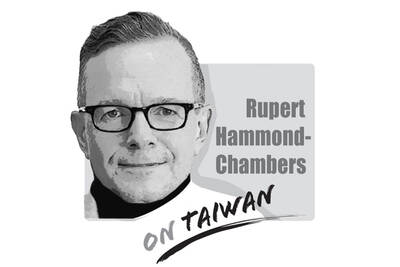Although news reports have been dominated by lawmakers’ scheduled review of the qualifications of Control Yuan member nominees and an ensuing vote at the Legislative Yuan this week, two more important issues await their consideration during the extraordinary session: changing the cover of the nation’s passport and adding “Taiwan” motifs to the fuselages of China Airlines (CAL) aircraft.
The motions for the changes have an interesting parallel with the nation’s previous efforts to update the cover of the passport by adding the word “Taiwan” in 2003, in that they were both prompted by a pandemic originating in China — SARS in 2003 and COVID-19 this year.
In both cases, the proposals reflect the desire of Taiwanese to be distinguished from Chinese, as anti-China sentiment swelled worldwide amid the outbreaks.
That desire was bolstered after photographs emerged showing batches of masks Taiwan had shipped overseas wrapped in banners reading “China Airlines,” leading to the misunderstanding that they were sent by Beijing, defeating the purpose of Taiwan’s so-called “pandemic diplomacy.”
While opposition parties have said that they are open to discussing the issues, problems and challenges loom over the proposals.
The Democratic Progressive Party’s (DPP) proposal regarding the passport cover states that the word “Taiwan” should be featured on the cover using the Latin alphabet and Chinese.
However, as the administration of former president Chen Shui-bian (陳水扁) in 2003 had already added the word “Taiwan” to the cover, the DPP’s proposal would only serve to add the Chinese characters, which would not be much help when it comes to distinguishing the nation from China in the international arena, as most of the world’s population cannot read Chinese.
There is also the question of whether the Chinese Nationalist Party’s (KMT) emblem, featured prominently on the cover, should be removed almost three decades after the KMT’s party-state rule ended with the dissolution of the National Assembly.
If the DPP, which has a legislative majority, does not want to be so bold as to abolish the current version of the passport, it should at least design a new cover — one that features “Taiwan,” complete with Chinese characters and a symbol that represents the nation.
This would put the issue of passport “name rectification” to bed, and the government can decide in a few years how it would go from there by gauging public opinion.
The same goes for highlighting “Taiwan” on China Airlines aircraft. To make for a meaningful change, the words “China Airlines” should be removed, and Taiwanese motifs should be introduced in their place.
Lawmakers should consider the potential fallout and work out a long-term solution that ensures the nation’s air rights after the words “China Airlines” are removed from the airplanes. Former China Airlines pilot Chen Hsiang-lin (陳祥麟) in an op-ed published in May by the Chinese-language news site The Reporter warned of the consequences of such a move.
In September 2003, to coincide with the new design of the passport cover, the Chen Shui-bian administration painted the words “Taiwan — Touch Your Heart” on the fuselage of a China Airlines airplane.
The plane was scheduled to make its maiden flight to Japan, but due to political pressure from Beijing, several airports around the world removed the aircraft’s tail number from their flight registration data, essentially denying it permission to land, Chen Hsiang-lin said, adding that the plane never left the hangar before China Airlines repainted its fuselage back to its standard decoration.

In the past month, two important developments are poised to equip Taiwan with expanded capabilities to play foreign policy offense in an age where Taiwan’s diplomatic space is seriously constricted by a hegemonic Beijing. Taiwan Foreign Minister Lin Chia-lung (林佳龍) led a delegation of Taiwan and US companies to the Philippines to promote trilateral economic cooperation between the three countries. Additionally, in the past two weeks, Taiwan has placed chip export controls on South Africa in an escalating standoff over the placing of its diplomatic mission in Pretoria, causing the South Africans to pause and ask for consultations to resolve
An altercation involving a 73-year-old woman and a younger person broke out on a Taipei MRT train last week, with videos of the incident going viral online, sparking wide discussions about the controversial priority seats and social norms. In the video, the elderly woman, surnamed Tseng (曾), approached a passenger in a priority seat and demanded that she get up, and after she refused, she swung her bag, hitting her on the knees and calves several times. In return, the commuter asked a nearby passenger to hold her bag, stood up and kicked Tseng, causing her to fall backward and
In South Korea, the medical cosmetic industry is fiercely competitive and prices are low, attracting beauty enthusiasts from Taiwan. However, basic medical risks are often overlooked. While sharing a meal with friends recently, I heard one mention that his daughter would be going to South Korea for a cosmetic skincare procedure. I felt a twinge of unease at the time, but seeing as it was just a casual conversation among friends, I simply reminded him to prioritize safety. I never thought that, not long after, I would actually encounter a patient in my clinic with a similar situation. She had
The election campaign for the Chinese Nationalist Party (KMT) chair is heating up, with only 10 days left before party members cast their ballots on Oct. 18. The campaign has revealed potential strengths for the party going into important elections next year and in 2028, particularly the desire among leading candidates to deepen cooperation with the Taiwan People’s Party (TPP). However, it has also exposed the party’s persistent weaknesses, especially in formulating a policy on cross-strait relations that can appeal to the majority of Taiwanese. Six candidates are registered: former Taipei mayor Hau Lung-bin (郝龍斌), 73; former legislator Cheng Li-wun